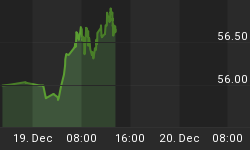Last time gold fell for 3 months running was March 2001. And so...?
It had become so rare, you could take its absence for granted to buy gold on the cheap.
Between March 2001 and April 2012, the price of gold never fell for 3 months in succession. So expecting "two months max" made for a great signal to buy gold on pullbacks, most recently in Jan. 2010 (your last chance below $1100) and April 2009 (last chance below $900).
That third month just never came. Until April 2012.

Three consecutive months of falling prices to buy gold are rare however you count it. Since 1957 in fact, they've struck only 65 times in a total of 661 three-month periods. And such drops - let's call them recessions to save me having to re-title these charts again - are rarer still in the US stock market.
The S&P has delivered only 55 runs of 3-month drops over the same 55-year period.

As both charts show, 3-month recessions are rarest of all in a runaway bull market. The S&P put in none between 1991 and 1999, just as prices to buy gold put in none between 2001 and spring 2012.
So, is this 3-month tumble the last straw for gold, finally snapping the camel's back after the big hump of $1920 per ounce in summer last year? After all, the big top of Jan. 1980 - after which gold prices spent two decades in decline - took almost a year to deliver a 3-month run of falling prices. Which then came thick and fast after that.
But 3-month declines don't necessarily signal a bear trend. The S&P suffered such falls in each of July, August and September last year - making for five monthly falls on the trot, in fact, over spring/summer 2011. But the US stock index still went on to recover and top that starting level. Just as it went on to recover and blast through its previous highs after hitting a run of 3-month recessions in 1990, not even mid-way through its long 18-year bull run.
Check also the sharp pullback in Dollar gold prices during 1975-76 on our chart above. Gold fell in seventeen of those 24 months, halving from top to bottom and recording ten 3-month recessions, more than during any other two-year period, including the early 1980s or the big Brown Bottom of the late 1990s.
Who was to know, amid that mid-70s bloodbath, that gold was on its way to rising 6-fold again?















